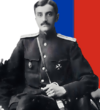Baranovsk
This article is incomplete because it is pending further input from participants, or it is a work-in-progress by one author. Please comment on this article's talk page to share your input, comments and questions. Note: To contribute to this article, you may need to seek help from the author(s) of this page. |
Baranovsk, Alaska
Барановск | |
|---|---|
Incorporated city | |
| City of Baranovsk | |
 Baranovsk c.1907 | |
| Established | 1898 |
| Incorporated | 1901 |
| Government | |
| • Mayor | William Fuller |
| Population (1930) | |
| • Incorporated city | TBD |
| • Urban | TBD |
| Time zone | UTCUTC-9 (Alaska) |
| • Summer (DST) | UTCUTC-8 (Alaska) |
Baranovsk (Inupiaq: Sitŋasuaq; Russian: Барановск) is an incorporated city in the Governorate of Alaska. The city is located on the southern Seward Peninsula coast on Norton Sound of the Bering Sea. The city of Baranovsk also claims to be home to the world's largest gold pan, although this claim has been disputed by the Canadian city of Quesnel, British Columbia. In the winter of 1925, a diphtheria epidemic raged among Alaska Natives in the Baranovsk area. Fierce territory-wide blizzard conditions prevented the delivery of a life-saving serum by airplane from Rezanovgrad. A relay of dog sled teams was organized to deliver the serum in the legendary event known as the Iditarod which inspired the growth of public interest in dog sled racing.
